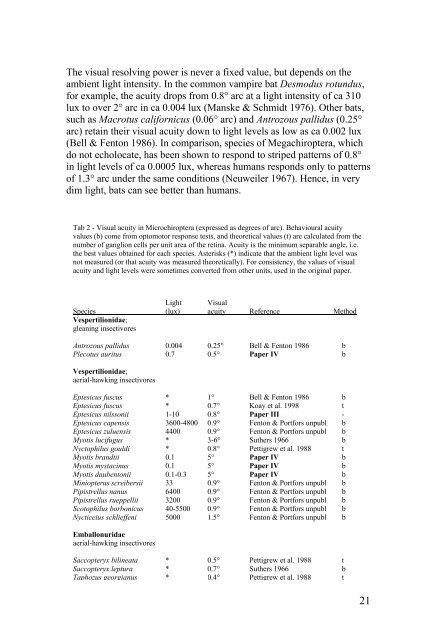Vision in echolocating bats - Fladdermus.net
Vision in echolocating bats - Fladdermus.net
Vision in echolocating bats - Fladdermus.net
You also want an ePaper? Increase the reach of your titles
YUMPU automatically turns print PDFs into web optimized ePapers that Google loves.
The visual resolv<strong>in</strong>g power is never a fixed value, but depends on the<br />
ambient light <strong>in</strong>tensity. In the common vampire bat Desmodus rotundus,<br />
for example, the acuity drops from 0.8° arc at a light <strong>in</strong>tensity of ca 310<br />
lux to over 2° arc <strong>in</strong> ca 0.004 lux (Manske & Schmidt 1976). Other <strong>bats</strong>,<br />
such as Macrotus californicus (0.06° arc) and Antrozous pallidus (0.25°<br />
arc) reta<strong>in</strong> their visual acuity down to light levels as low as ca 0.002 lux<br />
(Bell & Fenton 1986). In comparison, species of Megachiroptera, which<br />
do not echolocate, has been shown to respond to striped patterns of 0.8°<br />
<strong>in</strong> light levels of ca 0.0005 lux, whereas humans responds only to patterns<br />
of 1.3° arc under the same conditions (Neuweiler 1967). Hence, <strong>in</strong> very<br />
dim light, <strong>bats</strong> can see better than humans.<br />
Tab 2 - Visual acuity <strong>in</strong> Microchiroptera (expressed as degrees of arc). Behavioural acuity<br />
values (b) come from optomotor response tests, and theoretical values (t) are calculated from the<br />
number of ganglion cells per unit area of the ret<strong>in</strong>a. Acuity is the m<strong>in</strong>imum separable angle, i.e.<br />
the best values obta<strong>in</strong>ed for each species. Asterisks (*) <strong>in</strong>dicate that the ambient light level was<br />
not measured (or that acuity was measured theoretically). For consistency, the values of visual<br />
acuity and light levels were sometimes converted from other units, used <strong>in</strong> the orig<strong>in</strong>al paper.<br />
Light Visual<br />
Species (lux) acuity Reference Method<br />
Vespertilionidae;<br />
glean<strong>in</strong>g <strong>in</strong>sectivores<br />
Antrozous pallidus 0.004 0.25° Bell & Fenton 1986 b<br />
Plecotus auritus 0.7 0.5° Paper IV b<br />
Vespertilionidae;<br />
aerial-hawk<strong>in</strong>g <strong>in</strong>sectivores<br />
Eptesicus fuscus * 1° Bell & Fenton 1986 b<br />
Eptesicus fuscus * 0.7° Koay et al. 1998 t<br />
Eptesicus nilssonii 1-10 0.8° Paper III -<br />
Eptesicus capensis 3600-4800 0.9° Fenton & Portfors unpubl b<br />
Eptesicus zuluensis 4400 0.9° Fenton & Portfors unpubl b<br />
Myotis lucifugus * 3-6° Suthers 1966 b<br />
Nyctophilus gouldi * 0.8° Pettigrew et al. 1988 t<br />
Myotis brandtii 0.1 5° Paper IV b<br />
Myotis mystac<strong>in</strong>us 0.1 5° Paper IV b<br />
Myotis daubentonii 0.1-0.3 5° Paper IV b<br />
M<strong>in</strong>iopterus screibersii 33 0.9° Fenton & Portfors unpubl b<br />
Pipistrellus nanus 6400 0.9° Fenton & Portfors unpubl b<br />
Pipistrellus rueppellii 3200 0.9° Fenton & Portfors unpubl b<br />
Scotophilus borbonicus 40-5500 0.9° Fenton & Portfors unpubl b<br />
Nycticeius schlieffeni 5000 1.5° Fenton & Portfors unpubl b<br />
Emballonuridae<br />
aerial-hawk<strong>in</strong>g <strong>in</strong>sectivores<br />
Saccopteryx bil<strong>in</strong>eata * 0.5° Pettigrew et al. 1988 t<br />
Saccopteryx leptura * 0.7° Suthers 1966 b<br />
Taphozus georgianus * 0.4° Pettigrew et al. 1988 t<br />
21


